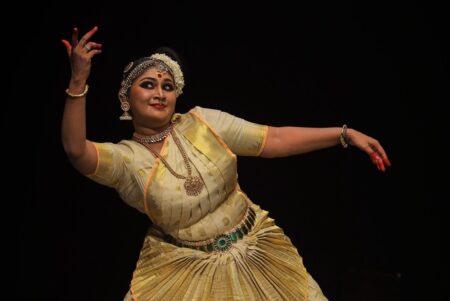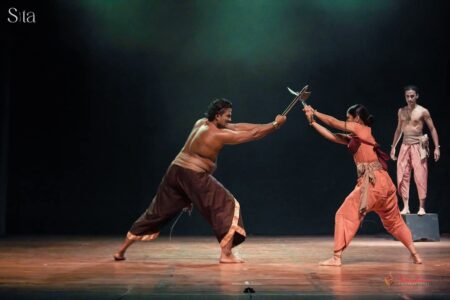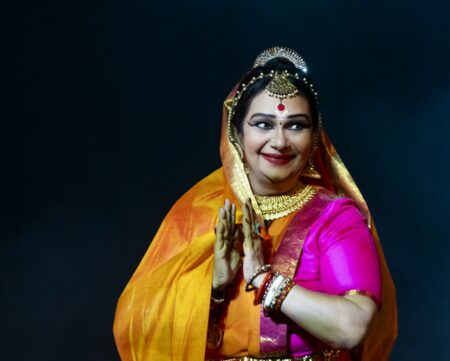Derived from Kathakali, Kerala Natanam was developed as an art form that would appeal to the masses.
Kathakali is a highly sophisticated art form. That said, it is performed as an ensemble and is an all-night affair. The elaborate costumes and make-up are very time consuming and is a difficult task. Also, the music of this oriental theatre is in chaste Malayalam which is not easily understood by a non-Malayali audience. Kathakali exponent Guru Gopinath who went out of Kerala tried to adapt Kathakali in a manner suitable for performance outside of Kerala without distorting or diluting the techniques. The idea was to create a dance form that would connect with the people more easily, unlike the classical form of Kathakali. Thus, he created a new unique dance form which later came to be known as Kerala Natanam.
This new art form was first performed on December 12, 1931, at the Opera house at Bombay in front of a large packed audience. Guru Gopinath, a youth of twenty-three, at that time, enacted Lord Krishna and American dancer Ragini Devi (Esther Sherman) was Radha.
Since it made its debut, it was readily accepted by the public and became extremely popular. As a result, many persons from outside Kerala and abroad came over to Kerala Kalamandalam (then the only institution offering training in this art form) to learn the art of Kathakali.
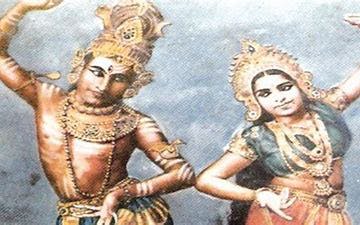
in Mumbai
In his book, Natanakairali Guru Gopinath says, “Kerala Natanam or Kerala Dance is a novel art form evolved from Kathakali and is comprised of nrutha (absolute or pure dance) nritya (dance with music and gesticulations) and natya (dramaturgy) and aangika (body gestures), vaachika (verbal), aahaarya (costumes and make up) saatvika (of temperaments and involuntary status) abhinaya (acting), in accordance with the taala mela (rhythm) order of the percussion instruments used in Kerala.”
Guru Gopinath created a whole repertoire of items in the Kerala Natanam style of dance. Though all the items are original works, they were initially based on selected extracts from the Kathakali attakathas and later encompassed a broad spectrum of themes. Works for solo, duet and group were created. The repertoire was revolutionary in that non-Hindu and socio-political themes were incorporated.
The costumes employed by Guru Gopinath adhered mostly to the theatre patterns, as found in traditional drama. Ekaharya costumes, as found in Bharata Natyam Kuchipudi, would not suit this style. According to Guru Gopinath, “a king should look like a king, a hunter like a hunter”. The audience should be immediately able to grasp the character portrayed on the stage.
Training methods
Bedsides Kathakali sangeetham (traditional Kathakali music) and Sopaana sangeetham (traditional Kerala music sung in the temples) Carnatic, Hindustani and folk types of music are used for this dance. A mix of vocal and instrumental music was employed depending on the nature of the items. For instance, a score in Megh Malhar would be used to introduce the Peacock Dance and the song would be in praise of Lord Muruga. Violin, flute, veena and mridangam were majorly used as accompanying instruments as per the situation. The ‘Garuda Nritta’, on the other hand, had only drums and various percussion instruments predominant. Other instruments employed were Chenda, Maddalam, Chengila and folk instruments like the Dol, Udukku, Conch, Cymbals, Gong and an assortment of percussive effects.
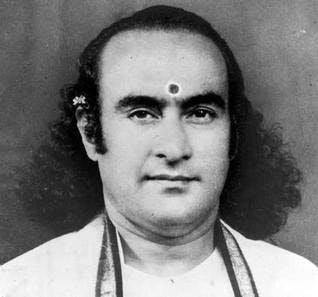
Guru Gopinath developed a syllabus and training schedule for Kerala Natanam and conducted classes in Thiruvananthapuram and Chennai. His curriculum for the teaching of the art form was largely based on Kathakali methodology. As in all types of Indian classical dance, there are four types of abhinaya used, and they are Aangika abhinaya — use of the various parts of the body like the head, hands, feet. Vaachika abhinaya — literally meaning speech but in this context refers to the music and lyrics of songs used in a dance. Ahaarya abhinaya — ornaments, costumes and garlands to decorate various parts of the body in the context of the role portrayed, and Saatvika abhinaya — when the artiste delves into the role in body and spirit and rises above routine interpretation which resonates with the audience.
A student is initiated into the dance form with the traditional obeisance to the almighty and guru. It is compulsory for this sequence to be performed by students or artists before and after every lesson, rehearsal session or concert. Later, various conditioning exercises are done to improve strength and flexibility.
Some of these exercises are as follows:
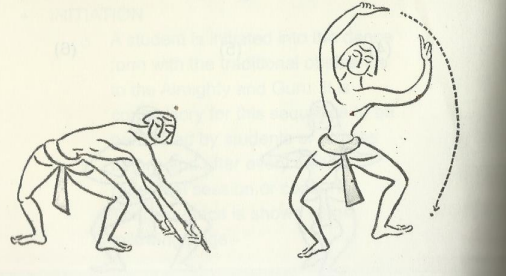
Valachu Veesal (Bending Exercise): Stand with your legs apart. With both hands stretched outward, bend over to the left side, till both index fingers touch the floor. Next, slowly straighten up the body in an arch. Both hands stretched out and bend over to the right side till both index fingers touch the floor. This exercise is repeated as required.
Kai Veesal (Hand Rotation): Stand straight, with legs together. Stretch both hands out, together, in front of you and rotate both hands, together, at the shoulders in a circular motion.
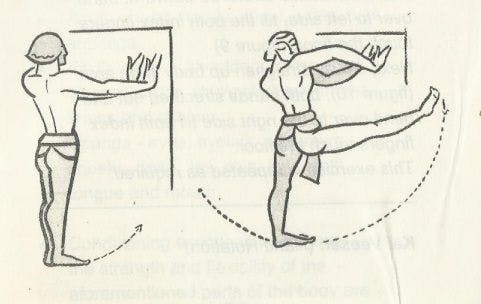
Kaal Veesal (Leg Exercise): Stand straight, facing a wall, and place both hands against the wall. Swing right leg, fully stretched, up on the right side to the maximum extent possible. Then swing the leg, in an arch to the opposite side, to the extent possible. Repeat with the left leg in the opposite direction.
Concurrent to the exercises, a student is taught the various talams (rhythms), method of keeping tala counts, vaithari (recitation of rhythmic syllables set to talas). The main talas used are — eka talam, panchari talam, triputa talam, chempada talam, jhampa talam, adantha talam and muri adantha talam. There are various sets of footwork set to different talams – in increasing and decreasing tempos. Footworks are classified into lasya (or feminine) and tandava (or masculine) types.
The Language of Mudras
Kathakali mudras are used in Kerala Natanam. These mudras are based on the `Hastha Lakshana Deepika’ (which differs slightly from the mudras used in Bharata Natyam which is based on the Abhinaya Darpana’). It would not be wrong to say that the use of Kathakali mudras is highly sophisticated and more developed than in any other dance form found outside Kerala. Students must be well versed in the use of mudras in all their complexity and a major portion of time is dedicated to learning this.
Kathakali mudras fall into four categories:
Samyutha mudras — mudras using both hands
Asamyutha mudras — single hand mudras
Samana mudras — holding the same mudras in both hands their connotations and usage in dance.
Misra mudras — holding different mudras in both hands concurrently -their connotations and usage in dance.
Once the student is proficient in the basics, they can learn Kerala Natanam items. The course based on Guru Gopinath’s curriculum for Kerala Natanam requires six years to complete.
Some of the items performed in the ‘Kerala Natanam’ category at Kerala Youth Festivals, for instance, leave much to be desired. In fact, at times it is even appalling. Although the Guru had blended elements from outside of Kathakali, like costumes, music and so on, there was no mistaking that Kathakali was the technique in the dance choreography itself. It is a pity that none of the creators of these so-called Kerala Natanam items at these festivals takes the trouble to consult Vjshwa Kalakendra (Guru Gopinath’s dance institution at Thiruvananthapuram), or any of the surviving students of Guru Gopinath and other Kerala Natanam artists of his era to get a proper foundation in it.
Write to [email protected]


